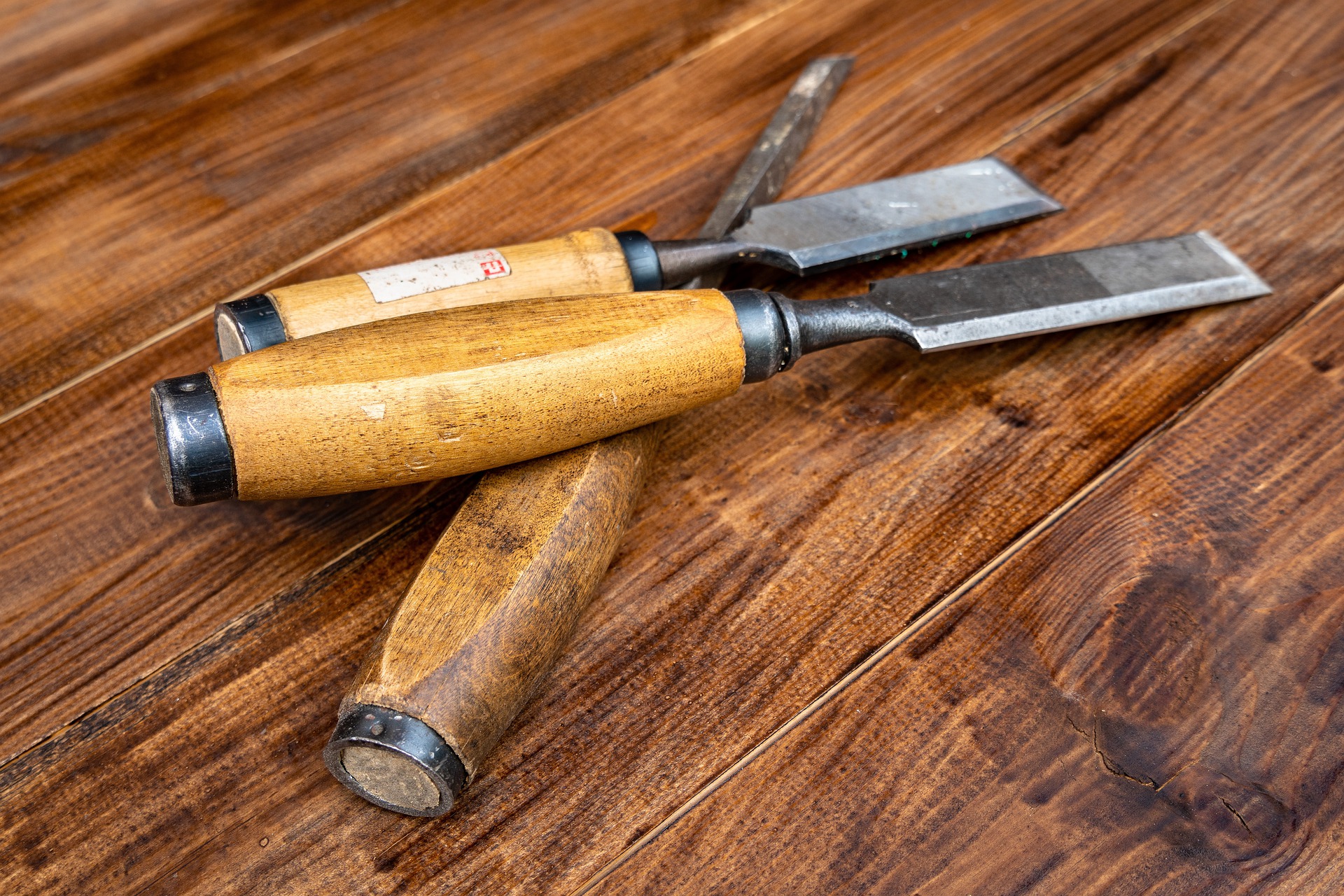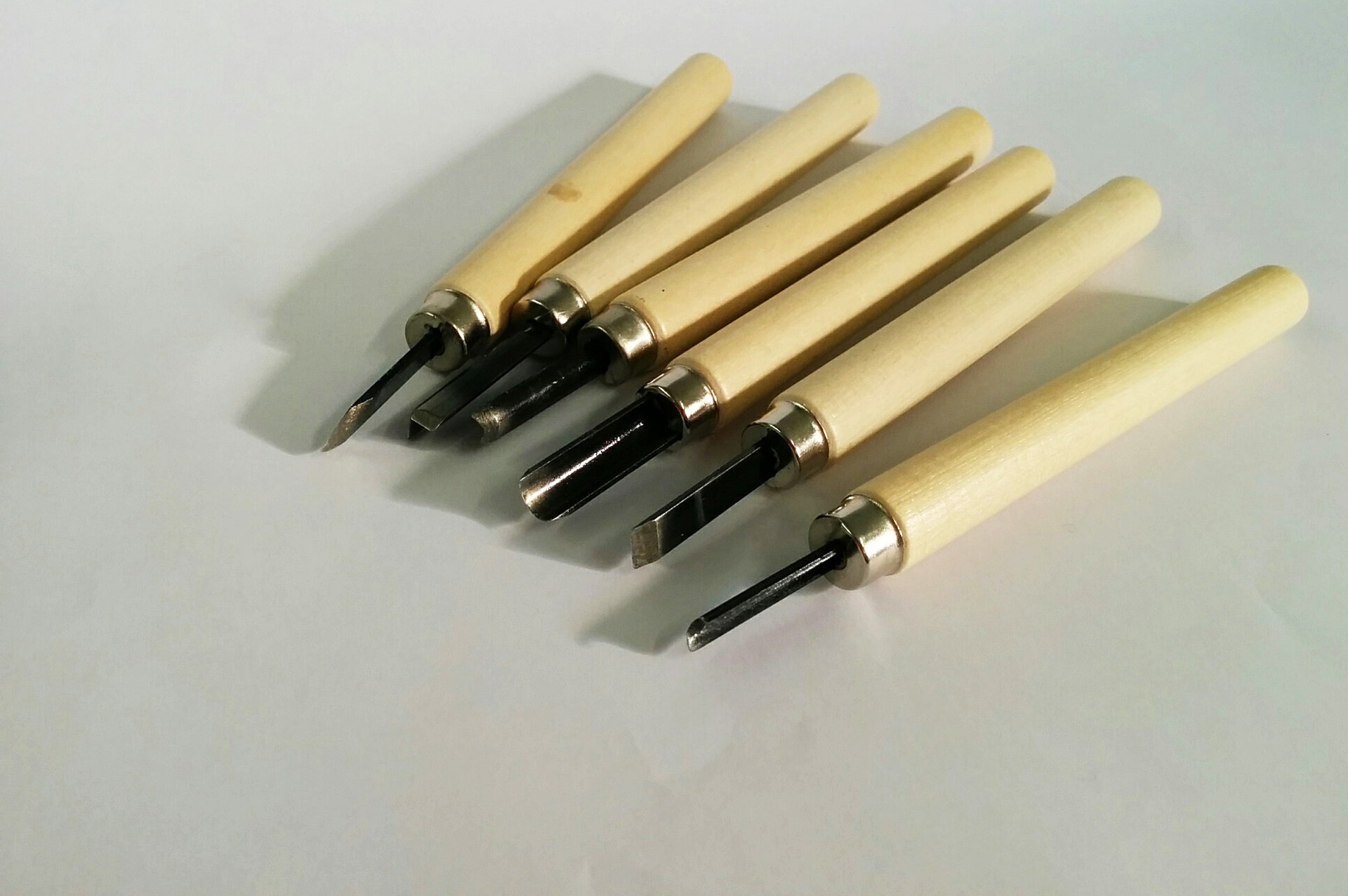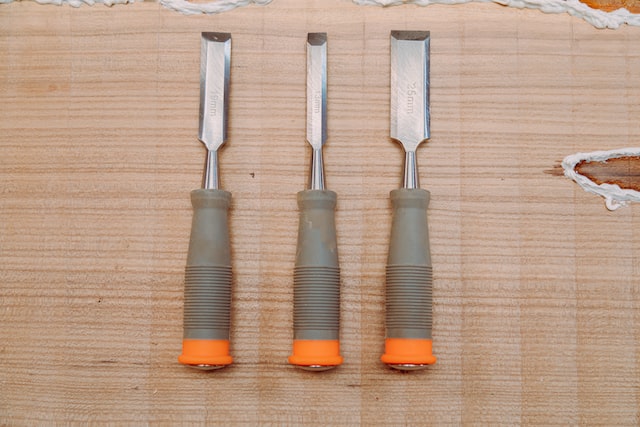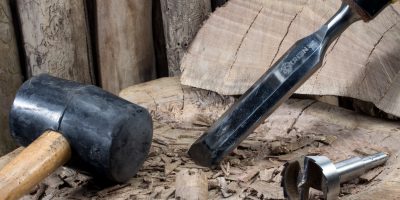Do you want to know how many types of chisels are there? Are you a beginner looking for the right type of chisel to use? Do you want to find out the different types of chisels so that you can make the best choice for your project?
If you answered yes to any of these questions, then this ultimate guide is for you.
Chisels are one of the most versatile and essential tools in any woodworker’s toolkit. From carving intricate details to shaping large pieces of wood, there is a chisel for every task. But with so many different types of chisels on the market, it can be tough to know which one is right for your project.
In this guide, we’ll break down the different types of chisels and their uses, so you can find the perfect tool for the job.

History of Chisels
A chisel is a tool that humans have used for thousands of years. The first chisels were made of stone and were used to carve wood and stone. Over time, the design of the chisel has evolved, and today there are many different types of chisels made from various materials.
The earliest chisels dated back to the Stone Age and were made from Flint, a type of stone known for its sharp edges. These early chisels were used to carve wood and bone.
As time passed, people began to make chisels from metals such as bronze and iron. These metal chisels were much sharper than stone and could be used for various tasks such as carving furniture and sculpture.
Modern chisels are made from various materials, including steel, stainless steel, and carbide. These materials allow for a sharper edge and a longer lifespan than the early chisels.
19 Common Types Of Chisels

Every chisel is designed for a specific purpose, so choosing the right tool for the job is important. Here are 17 of the most common types of chisels and their uses:
1. Mortise Chisels
A mortise chisel is a type of chisel with a square or rectangular cross-section and is designed for cutting mortises, which are square or rectangular holes. Mortise chisels are available in various sizes and styles, and you can use them with a mallet or hammer.
The blade of a mortise chisel is usually beveled on one side to create a sharp edge, and the other side is flat so that it can register against the surface of the workpiece. When using a mortise chisel, mark the desired mortise on the workpiece. Then, use the chisel to score the mortise’s outline on the material’s surface.
Next, use a series of strikes with a mallet or hammer to remove waste material from within the scored outline. Finally, use the chisel to clean up any rough edges and ensure that the mortise’s sides are perpendicular to the surface of the workpiece.
Mortise chisels are an essential tool for anyone who works with wood or other materials that can be mortised.
2. Paring Chisels
Paring chisels are one of the most versatile and essential tools in a woodworker’s toolkit. As the name suggests, they are primarily used for paring – or shaving – wood but can also be used for other tasks such as mortising, shaping, and even cleaning up machine-cut joints.
Paring chisels come in various sizes, from small detail chisels to larger ones that can handle more robust work. The size and shape of the blade will vary depending on the intended use, but all paring chisels share a few key features.
Firstly, they have a relatively thin blade, often beveled on both sides. This allows the chisel to produce clean, tight cuts without tearing out the wood grain. Additionally, the blade is set at the handle angle, giving greater control and precision when paring.
There are many ways to use a paring chisel, but some of the most common uses include shaving off small bits of wood to create a smooth surface, shaping curved edges, and cleaning out Mortise-and-tenon joints. Paring chisels are an essential tool for any woodworker, and the different sizes and shapes allow you to tackle a wide range of projects.
3. Socket Chisels
A socket chisel is a type of chisel with a blade set into a socket in the handle. This design gives the socket chisel several advantages over other types of chisels:
- It makes the chisel more durable and less likely to break.
- It provides a more comfortable grip and gives the user more control over the chisel.
- It allows the blade to be replaced if it becomes damaged or dull.
Socket chisels are available in various sizes, and the blades can beveled or flat. The most common use for a socket chisel is chopping out waste material, such as when making Mortise-and-tenon joints.
However, you can also use them for other tasks such as shaping and paring. When using a socket chisel, it is important to hold it firmly and to use a wooden mallet or hammer, as this will help to protect the socket from damage.
Socket chisels are a versatile and essential tool for any woodworker, and the blades can be replaced, making them even more useful. If you are looking for a durable and comfortable chisel, then a socket chisel is a great option.
4. Bevel-Edge Chisels
A bevel-edge chisel is a carpentry tool with a blade that tapers to a sharp edge at the end. The blade is set at an angle, typically around 25 degrees, so you can use it for cutting tasks such as shaping wood joints or trimming off excess material.
Bevel-edge chisels are versatile tools that you can use for various woodworking tasks. The most common use for a bevel-edge chisel is shaping wood joints. When used correctly, a bevel-edge chisel can produce clean, precise cuts resulting in a tight, professional-looking joint. Bevel-edge chisels can also be used for trimming excess material from woodworking projects.
For example, if you need to remove a small amount of material from the edge of a piece of wood, you can use a bevel-edge chisel to cut. Bevel-edge chisels are available in various sizes and shapes, so it’s important to choose the right tool for the job. Smaller chisels are ideal for delicate work, while larger chisels can handle more heavy-duty tasks.
When using a bevel-edge chisel, it is important to hold it at the correct angle. The blade should be perpendicular to the piece of wood you are working on. Additionally, it would be best to use a wooden mallet or hammer to strike the chisel, as this will help prevent the chisel from slipping.
5. Flat Chisels
Flat chisels have a wide, flat blade used to clean up flat surfaces or make precise cuts in soft materials. The blade of a flat chisel is usually between 2 and 6 inches long, and the handle is typically made of wood or metal.
While carpenters and woodworkers commonly use flat chisels, masons and stone carvers can also be used for shaping and trimming stone. In addition, flat chisels can be used to remove paint from surfaces or to score plaster or drywall.
6. Cold Chisels
A cold chisel is a tool made of hardened steel used to shape metal. The blade of a cold chisel is usually beveled, and the handle is generally round, making it easy to grip. The most common use for a cold chisel is to chip away at the metal to create the desired shape.
For example, a blacksmith might use a cold chisel to create intricate patterns in ironwork. Cold chisels can also remove rust from metal surfaces or cut through tough materials like nails or screws. Despite its name, you can also use a cold chisel with heat; applying heat to the metal before using the chisel will make the metal easier to work with.
7. Japanese Chisels
Japanese chisels, also known as “kiridashi,” are small hand tools used for various woodworking tasks. The blade of a Japanese chisel is typically less than 2 inches long, and the handle is usually made of wood.
Japanese chisels are used to cut dovetails, shape wood joints, and carve intricate designs. The small size of Japanese chisels makes them ideal for detailed work, and you can sharpen the blades to a very fine edge, making them ideal for delicate cuts.
8. Sash Mortise Chisels
The blade of a sash mortise chisel is thinner than that of a standard chisel, and it tapers to a point, making it ideal for creating precise and clean cuts. Sash mortise chisels are most commonly used in furniture making and cabinetry, but you can also use them for other woodworking projects, such as creating door frames or window frames.
When choosing a sash mortise chisel, selecting one with a comfortable handle that will provide good grip and balance is important. The chisel size should also be appropriate for the project at hand. For smaller projects, a 1/4-inch or 3/8-inch chisel may be sufficient, but for larger projects, a 1/2-inch or larger chisel may be necessary.
9. Bench Chisel
A bench chisel is a multi-purpose chisel with a sharp blade for chopping wood. The blade is attached to a handle, which is either bolted or screwed into the blade. The most common type of bench chisel has a rectangular cross-section, but there are also versions with a round or oval cross-section.
The blade is usually made from carbon steel or high-speed steel. Bench chisels vary in size from 1/4 inch to 2 inches wide. The larger the chisel, the more force it can exert on the wood. The smaller chisels are used for finer work, such as carving details or shaping moldings.
10. Firmer Chisel

A firmer version is one of the four types of chisels commonly used in woodworking projects. It has a thick, powerful blade that can remove big chunks of wood with a single hit. When the end of this chisel is hammered with a mallet, the 4-inch (10.16-cm) blade is powerful enough to make deep, massive joints.
This chisel has a beveled edge and is suitable for general woodworking jobs. A beveled edge chisel, also known as a butt chisel, is a firmer chisel with slopes on both sides of the cutting surface for finer trimming.
This is one of the oldest types of chisels in use. They may have evolved from using sharpened rocks in the Stone Age to cut away undesirable material and trim skins. Over time, it added wooden grips to enhance comfort while using the tool and to allow force to be exerted by striking the handle with the palm of one’s hand, a hammer, or a mallet.
Different chisels are meant for specific tasks, but the firmer chisel is still a useful complement to a basic woodworking toolbox, particularly for cutting grooves with acute angles.
11. Masonry Chisel
A masonry chisel is a type of chisel that is used to cut and shape stone, brick, and concrete. It has a sharp, narrow blade that can penetrate hard materials. Furthermore, the chisel is often combined with a hammer to create precise cuts.
Masonry chisels come in various sizes, and the size of the chisel will determine its use. The most common sizes are 1/2 inch, 3/4 inch, and 1 inch. Masonry chisels can create any number of shapes, such as square holes, round holes, or V-shaped grooves.
You can also use them to remove excess material around doors and windows. In addition, masonry chisels can be used to score lines in stone or concrete so you can easily break them into smaller pieces.
12. Framing Chisel
A framing chisel has a thicker, wider, and longer blade than standard chisels. The blades of these chisels can be either straight or beveled. Framing chisels have characteristics like loops, sockets, or capped handles so that they can endure being hit repeatedly with a mallet.
A framing chisel’s bevel can be anywhere between 25 and 30 degrees. Framing chisels are necessary for timber framing, shipbuilding, and other forms of post-and-beam construction. Moreover, the chisels cut large mortises and dadoes in wood. In addition, you can also use them to remove nails from lumber.
13. Skew Chisel
A skew chisel is a flat-edged, long chisel with an angled tip. The toe is the longest point of the chisel’s cutting edge, and the heel is the smallest point of the cutting edge. The toe of the skew chisel is usually what gets the inexperienced woodturner into problems with the skew chisel. If placed incorrectly, the toe might easily dig into the turning unsettlingly.
Before working with a skew chisel, study how to present the tool to the wood safely. If you want to avoid dig-ins, which typically happen when the toe of the skew chisel makes contact with the wood too forcefully, you should hold the tool such that the toe is not touching wood. Instead, the cutting edge should contact the wood at an angle.
14. Fishtail Chisel
A fishtail chisel is a chisel with a cutting edge that is tapered to a point. It is named for its distinctive shape, which resembles the tail of a fish. Fishtail chisels are used for a variety of tasks, including carving intricate designs, shaping rebates and slots, and cutting dovetail joints.
They are also often used for making small adjustments to the size and shape of woodworking projects. In order to use a fishtail chisel effectively, it is important to select the correct size and type of chisel for the task at hand.
There are two main types of fishtail chisels: those with a beveled edge and those with a straight edge. Beveled-edge fishtail chisels are used for tasks that require a precise, clean cut. Straight-edge fishtail chisels are better suited for tasks that require a more aggressive cut.
The size of the chisel will also dictate its use. Smaller fishtail chisels are typically used for delicate tasks, while larger chisels can be used for more heavy-duty work.
15. Tang Chisels
Tang chisels have a shank that tapers to a point and is pushed into a handle. The handle is held in place with a ferrule. The blade is usually made of high carbon steel, hardened and tempered for strength and durability.
The tang can be either straight or curved, depending on the desired effect. The straight tang is typically used for cutting precise lines, while the curved tang is more suitable for creating smooth, flowing shapes.
16. Butt Chisel
Butt chisels have a distinctively short blade. Furthermore, butt chisels are thought to have evolved from harder or bench chisels that were then reshaped and recut to the point where the blades were only a few inches long. Butt chisel blades are available with both straight and bevel edges.
Butt chisels, as the name implies, are used to install butts and hinges. Carpenters find these little instruments so useful that there has been a rise in the production of these hand tools.
17. Cape Chisel
The cold chisel category includes the Cape chisel. These chisels’ pointy tips resemble arrowheads. In the same way, as cold chisels are used to cut softer metals, cape chisels are used to cut harder metals. Cutting keyways, creating horizontal groves, and adding fine details to metal surfaces are all excellent uses for cape chisels with sharpened tips.
The size of the cape chisel will determine what you can use it for. Cape chisels come in a variety of sizes; the larger ones are great for cutting through bolts, while the smaller ones are better suited for finer tasks like making dovetails.
18. Corner Chisel
Corner chisels are small hand tools used to create precise square niches in wood. The original recess is frequently formed with a router, leaving a rounded hole. A corner chisel aims to carve that round hole to create it more angled or square.
They’re commonly used to square off hinge recesses in doors that have been routed or drilled. The cutting edge of a corner chisel is beveled on both sides and can vary in length from 1-1/2 to 2 inches.
19. Hot Chisel
A hot chisel is a chisel that is used to cut metal. The cutting edge of a hot chisel is heated until it is red-hot. The hot chisel is then placed against the metal and allowed to cool. As it cools, the metal will contract and break along the chisel’s cutting edge.
Hot chisels are used to cut metal that is too hard to be cut with a cold chisel. The heat from the hot chisel makes the metal softer and easier to cut.
Frequently Asked Questions
Q: Can a woodworking chisel be used on metal?
A. No, you cannot use a woodworking chisel on metal. Metal is much harder than wood, and the chisel will not be able to cut through it. You must use a hot chisel or a cape chisel to cut metal.
Q: What are the common types of chisel handles?
A: Common chisel handles include cylindrical, tang, and sockets.
Q: How does a chisel work?
A: A chisel is a hand tool that cuts or removes material from a workpiece. The chisel’s cutting edge is placed against the material and then struck with a hammer or mallet to cut through it.
Q: Which type of chisel is best for cutting metal?
A: A hot or cape chisel is best for cutting metal.
Final Words
Chisels come in all shapes and sizes, each with its own unique purpose. With this guide, you should now understand the different types of chisels and what you can use them for. So the next time you are in the market for a new chisel, you will know exactly which one to get for the job.


